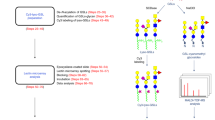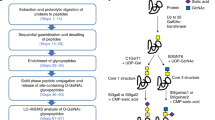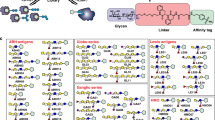Abstract
Glycosyltransferases catalyze the reaction between an activated sugar donor and an acceptor to form a new glycosidic linkage. Glycosyltransferases are responsible for the assembly of oligosaccharides in vivo and are also important for the in vitro synthesis of these biomolecules. However, the functional identification and characterization of new glycosyltransferases is difficult and tedious. This paper describes an approach that combines arrays of reactions on an immobilized array of acceptors with an analysis by mass spectrometry to screen putative glycosyltransferases. A total of 14,280 combinations of a glycosyltransferase, an acceptor and a donor in four buffer conditions were screened, leading to the identification and characterization of four new glycosyltransferases. This work is notable because it provides a label-free method for the rapid functional annotation of putative enzymes.
This is a preview of subscription content, access via your institution
Access options
Subscribe to this journal
Receive 12 print issues and online access
$259.00 per year
only $21.58 per issue
Buy this article
- Purchase on Springer Link
- Instant access to full article PDF
Prices may be subject to local taxes which are calculated during checkout


Similar content being viewed by others
References
Ohtsubo, K. & Marth, J.D. Glycosylation in cellular mechanisms of health and disease. Cell 126, 855–867 (2006).
Koeller, K.M. & Wong, C.H. Enzymes for chemical synthesis. Nature 409, 232–240 (2001).
Blixt, O., van Die, I., Norberg, T. & van den Eijnde, D.H. High-level expression of the Neisseria meningitidis lgtA gene in Escherichia coli and characterization of the encoded N-acetylglucosaminyltransferase as a useful catalyst in the synthesis of GlcNAcβ1→3Gal and GalNAcβ1→3Gal linkages. Glycobiology 9, 1061–1071 (1999).
Yu, H. et al. A multifunctional Pasteurella multocida sialyltransferase: a powerful tool for the synthesis of sialoside libraries. J. Am. Chem. Soc. 127, 17618–17619 (2005).
Breton, C. et al. Structures and mechanisms of glycosyltransferases. Glycobiology 16, 29R–37R (2006).
Yi, W. et al. Bacterial homologue of human blood group A transferase. J. Am. Chem. Soc. 130, 14420–14421 (2008).
Li, M. et al. Characterization of a novel α 1,2-fucosyltransferase of Escherichia coli O128: B12 and functional investigation of its common motif. Biochemistry 47, 378–387 (2008).
Aharoni, A. et al. High-throughput screening methodology for the directed evolution of glycosyltransferases. Nat. Methods 3, 609–614 (2006).
Cantarel, B.L. et al. The Carbohydrate-Active EnZymes database (CAZy): an expert resource for glycogenomics. Nucleic Acids Res. 37, D233–D238 (2009).
Houseman, B.T. & Mrksich, M. Carbohydrate arrays for the evaluation of protein binding and enzymatic modification. Chem. Biol. 9, 443–454 (2002).
Su, J. & Mrksich, M. Using mass spectrometry to characterize self-assembled monolayers presenting peptides, proteins, and carbohydrates. Angew. Chem. Int. Ed. Engl. 41, 4715–4718 (2002).
Min, D.H., Su, J. & Mrksich, M. Profiling kinase activities by using a peptide chip and mass spectrometry. Angew. Chem. Int. Edn Engl. 43, 5973–5977 (2004).
Ban, L. & Mrksich, M. On-chip synthesis and label-free assays of oligosaccharide arrays. Angew. Chem. Int. Edn Engl. 47, 3396–3399 (2008).
Mrksich, M. Mass spectrometry of self-assembled monolayers: a new tool for molecular surface science. ACS Nano 2, 7–18 (2008).
Gurard-Levin, Z.A., Scholle, M.D., Eisenberg, A.H. & Mrksich, M. High- throughput screening of small molecule libraries using SAMDI mass spectrometry. ACS Comb. Sci 13, 347–350 (2011).
Fang, J.W. et al. Highly efficient chemoenzymatic synthesis of α-galactosyl epitopes with a recombinant α(1→3)galactosyltransferase. J. Am. Chem. Soc. 120, 6635–6638 (1998).
Min, D.H., Yeo, W.S. & Mrksich, M. A method for connecting solution-phase enzyme activity assays with immobilized format analysis by mass spectrometry. Anal. Chem. 76, 3923–3929 (2004).
Guan, W. et al. Combining carbochips and mass spectrometry to study the donor specificity for the Neisseria meningitidis β 1,3-N-acetylglucosaminyltransferase LgtA. Bioorg. Med. Chem. Lett. 21, 5025–5028 (2011).
Leskovac, V. Comprehensive Enzyme Kinetics 1st edn (Springer, New York, 2003).
Cleland, W.W. Statistical analysis of enzyme kinetic data. Methods Enzymol. 63, 103–138 (1979).
Bella, A., Whitehead, J.S. & Kim, Y.S. Human plasma uridine diphosphate galactose-glycoprotein galactosyltransferase: purification, properties and kinetics of the enzyme-catalyzed reaction. Biochem. J. 167, 621–628 (1977).
Breton, C., Mucha, J. & Jeanneau, C. Structural and functional features of glycosyltransferases. Biochimie 83, 713–718 (2001).
Rillahan, C.D. & Paulson, J.C. Glycan microarrays for decoding the glycome. Annu. Rev. Biochem. 80, 797–783 (2011).
Park, S. & Shin, I. Carbohydrate microarrays for assaying galactosyltransferase activity. Org. Lett. 9, 1675–1678 (2007).
Blixt, O. et al. Glycan microarrays for screening sialyltransferase specificities. Glycoconj. J. 25, 59–68 (2008).
Kosík, O. et al. Polysaccharide microarrays for high-throughput screening of transglycosylase activities in plant extracts. Glycoconj. J. 27, 79–87 (2010).
Laurent, N. et al. Enzymatic glycosylation of peptide arrays on gold surfaces. ChemBioChem 9, 883–887 (2008).
Chang, S.-H. et al. Glycan array on aluminum oxide–coated glass slides through phosphonate chemistry. J. Am. Chem. Soc. 132, 13371–13380 (2010).
Sanchez-Ruiz, A., Serna, S., Ruiz, N., Martin-Lomas, M. & Reichardt, N.-C. MALDI-TOF mass spectrometric analysis of enzyme activity and lectin trapping on an array of N-glycans. Angew. Chem. Int. Edn Engl. 50, 1801–1804 (2011).
Palcic, M.M. & Hindsgaul, O. Flexibility in the donor substrate specificity of β 1,4-galactosyltransferase: application in the synthesis of complex carbohydrates. Glycobiology 1, 205–209 (1991).
Cerdeño-Tárraga, A.M. et al. Extensive DNA inversions in the B. fragilis genome control variable gene expression. Science 307, 1463–1465 (2005).
Acknowledgements
M.M. acknowledges the National Science Foundation (EEC-01180205), US National Institutes of Health (P50 GM086145) and Defense Advanced Research Projects Agency (FA 9550-08-1-0221), and P.G.W. acknowledges the National Basic Research Program of China (973 Program, no. 2012CB822100 and no. 2012CB910300) for financial support. L.L. acknowledges support from the China Scholarship Council (2007102057). We thank J. Modica for assistance with synthesis. We thank Z.-J. Liu (Institute of Biophysics of the Chinese Academy of Sciences) for providing the vector pMCSG7.
Author information
Authors and Affiliations
Contributions
L.B., A.D.S. and L.C. performed the synthesis of sugar acceptors. N.P., L.L., W.C., W.G. and W.H. constructed the plasmids and expressed the proteins. L.B. and A.D.S. performed the screening reactions. P.G.W. and M.M. provided project management. L.B., A.D.S., P.G.W. and M.M. prepared the manuscript.
Corresponding authors
Ethics declarations
Competing interests
The authors declare no competing financial interests.
Supplementary information
Supplementary Text and Figures
Supplementary Methods and Supplementary Results (PDF 2397 kb)
Rights and permissions
About this article
Cite this article
Ban, L., Pettit, N., Li, L. et al. Discovery of glycosyltransferases using carbohydrate arrays and mass spectrometry. Nat Chem Biol 8, 769–773 (2012). https://doi.org/10.1038/nchembio.1022
Received:
Accepted:
Published:
Issue Date:
DOI: https://doi.org/10.1038/nchembio.1022
This article is cited by
-
Recent Advances in Rapid Screening Methods for Glycosyltransferases
Catalysis Letters (2024)
-
Small tools for sweet challenges: advances in microfluidic technologies for glycan synthesis
Analytical and Bioanalytical Chemistry (2022)
-
Improved production of 2′-fucosyllactose in engineered Saccharomyces cerevisiae expressing a putative α-1, 2-fucosyltransferase from Bacillus cereus
Microbial Cell Factories (2021)
-
A MALDI-MS sensing chip prepared by non-covalent assembly for quantitation of acid phosphatase
Science China Chemistry (2021)
-
Recent advances in high-throughput mass spectrometry that accelerates enzyme engineering for biofuel research
BMC Energy (2020)



